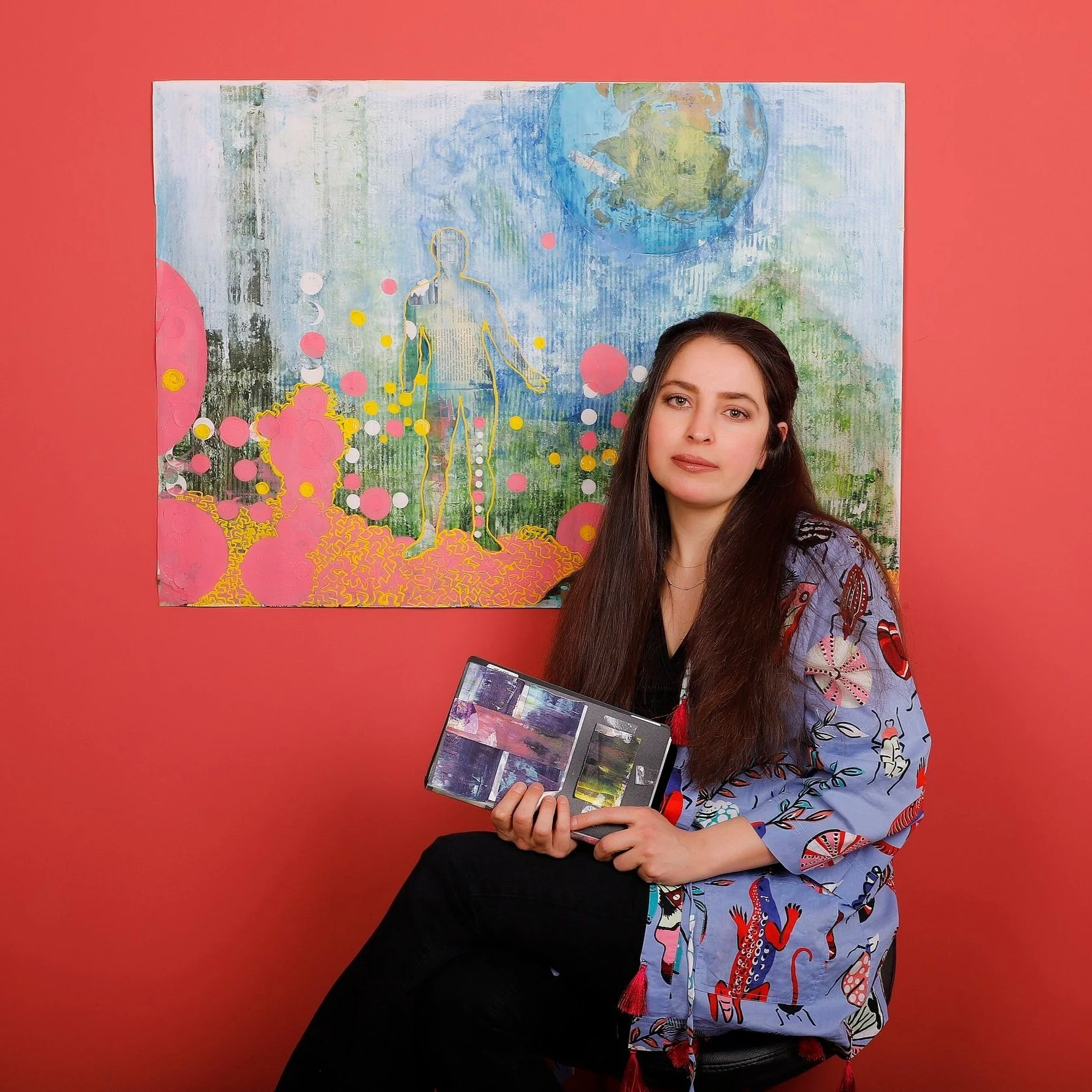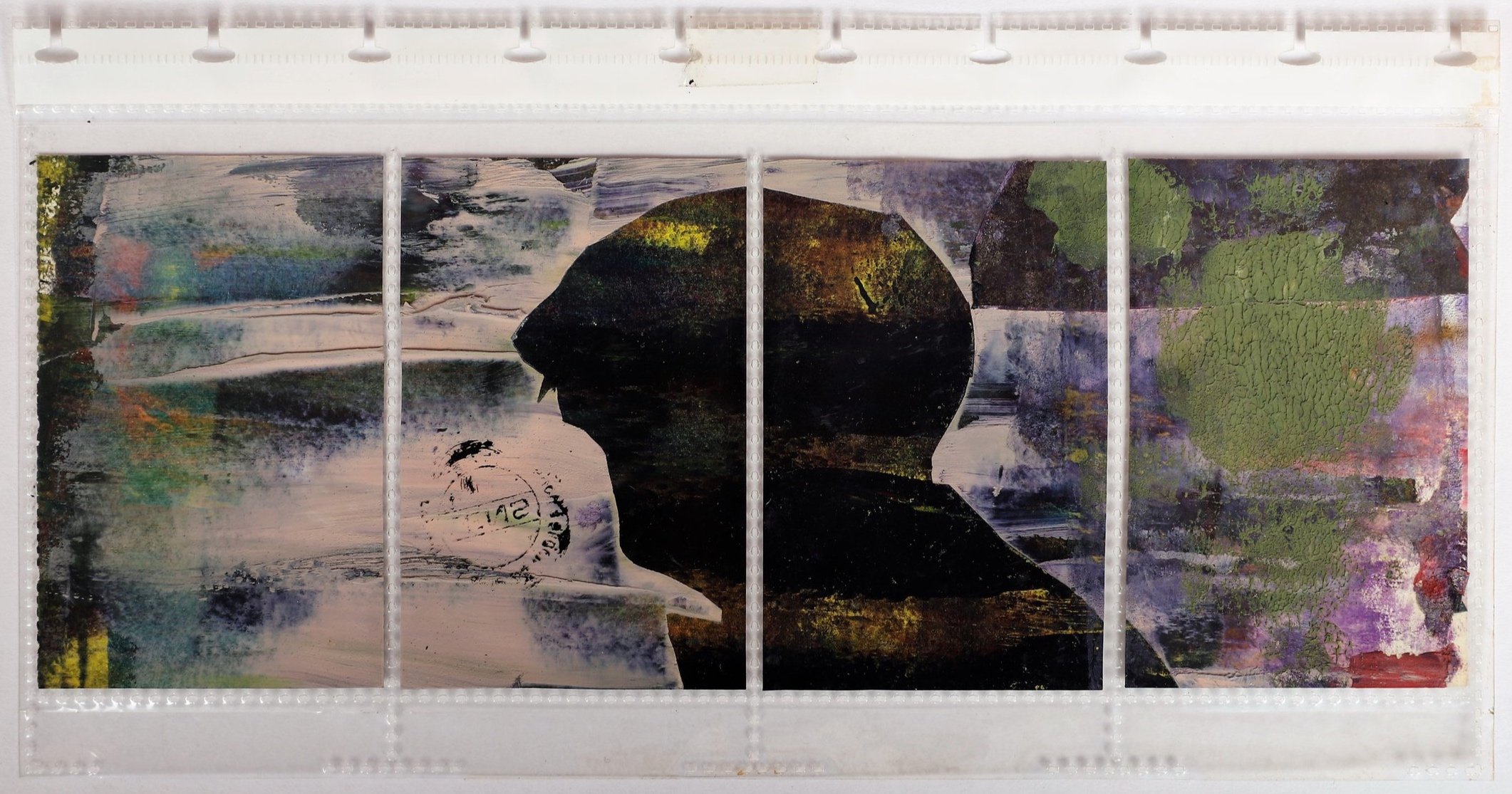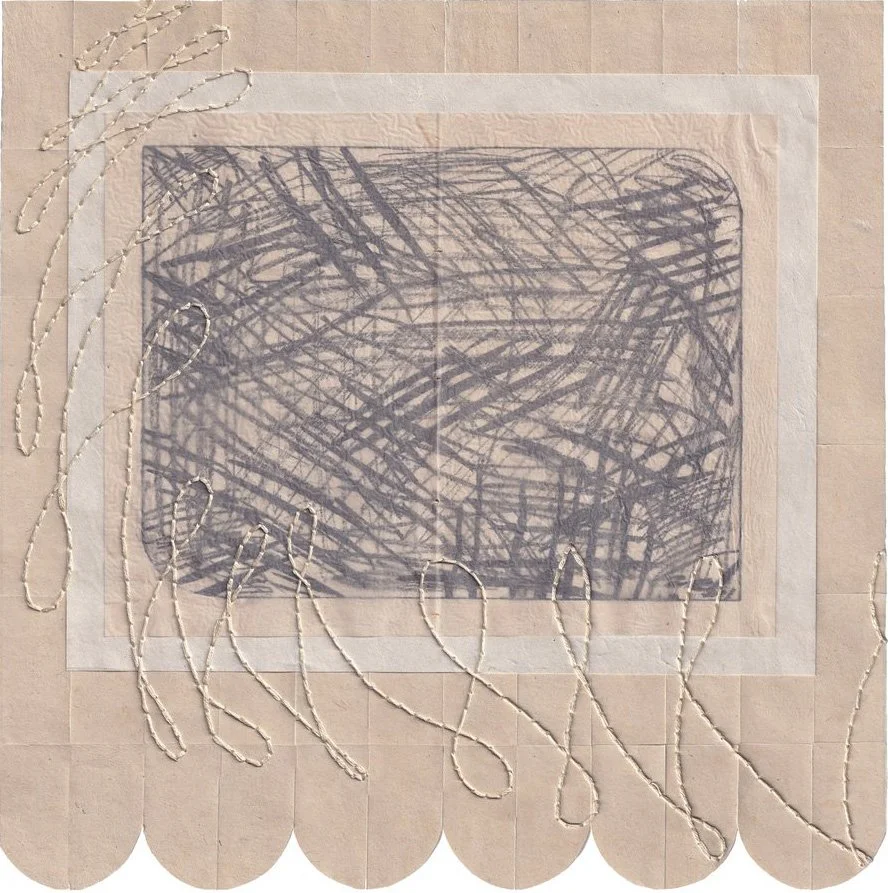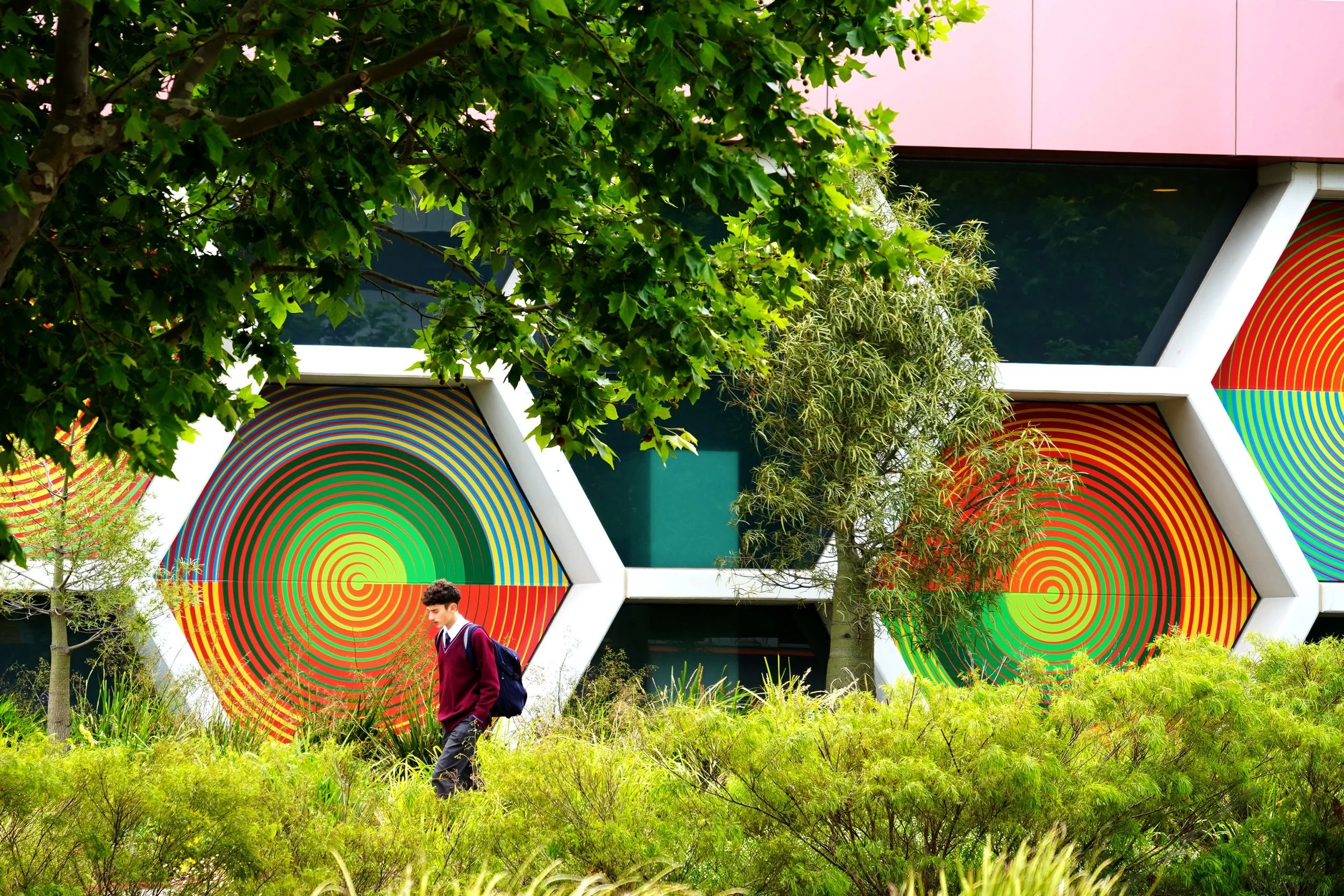10 Questions with Saliha Kaytan
Saliha Kaytan was born in Türkiye. After continuing her high school education in Germany for a while, she returned to Türkiye. During these years, she developed a professional interest in art, and after completing her undergraduate education in this field, she worked as an art instructor for a long time and continues to work as a part-time instructor. During the years when she did not produce regularly, she continued her research and experimental practices by concentrating on the underlying issue. Following this experience, she decided to open a studio and pursue a master's degree in plastic arts. She wrote a thesis on the evolution of automatism in the movements of surrealism and abstract expressionism, which she considered to be the most similar to her own. Producing works with a multidisciplinary approach, the artist cuts different paintings on fabrics and reassembles them by sewing with her hands. Continuing her understanding of art with an automatist attitude, the artist actively uses decalcomania, frottage, and ritual techniques on paper and canvas, unlike stitching. The artist, who examines memory in general with an inductive method, examines rational and irrational phenomena by underlining the contrast between the emotions and behaviors of the human being in this cycle. She tries to carry this to a collective dimension based on her own memory.
Saliha Kaytan - Portrait
ARTIST STATEMENT
The transformation of information into a new kind of information via mental stages has enabled it to be passed down to future generations. This set of functions constitutes memory. Individual, collective, and cultural memory, which is divided into three parts by scientists, is the result of intergenerational transmission. The artist, who believes that knowledge cannot be personal but is passed down through inheritance, supposes that the knowledge we have is the result of collective and cultural memory. Cultural memory has a power that defies time against the ages. In this context, the artist cuts and sews the canvases he made in different places and dates. The cycle of a piece of cloth travels from individual memory to cultural memory in a reverse time flow. In this way, the artist seeks to bring attention to the effect of ambiguous cultural memory formation on human memory over time by accessing information in his mind through automatism.
Women has no name, Pastel on encyclopedia paper, 12x19 cm, 2018 © Saliha Kaytan
INTERVIEW
First of all, introduce yourself to our readers. Who are you, and how did you start experimenting with art?
I was born in Türkiye in 1989. My homeland was a culturally rich place that had witnessed many civilizations. I think I wear this richness on my sleeve. I used to be a little tailor in my childhood, sewing clothes for my dolls, making crafts, and experimenting with painting. This sense of curiosity, which I considered a hobby and a game at the time, enabled me to step into the world of art professionally when I reached high school years, a highly qualified teacher helped me to discover it. I have tried so many things that I don't know how many, and there are still so many things I want to try. Therefore, I don't think I will ever be able to produce works that are just variations of each other. That's because when I encounter a new situation, a new layer opens up in my mind, and if what I have tried so far is not satisfactory for this new situation, I start the process of experimenting again. It's as if there is a child inside me independent of me, and if I don't fulfill her wishes, she will never give me peace.
Why did you choose to pursue art as your career? What motivates you to create?
Like I mentioned above, my talent was discovered during my high school years, but more important than that was my discovery of art. There was no one around me who could be an example for me in this regard. And when I met art truly, time stopped for me. My art teacher made a connection between Van Gogh and me because I always cut my own hair, and she would even joke about it. Of course, I didn't cut off my ear, but I was very interested in Van Gogh. This magical world had summoned me. I was planning to pursue my education and future career in psychology up to that day, and I was doing very well in my classes, but art made me give it all up. I felt so deeply that there was a place for me there. And I chose the way of art.
What motivates me to create is that it doesn't have to depend on anything, and it is limitless. I think this is where the real power of art comes from. The feeling of creation is like a challenge to me, a challenge to life. People are often obsessed with a function, but for an artist, a function is often a wall that needs to be torn down. This means destroying the functionality or habit that people impose on any object, not only for objects but for all habits, points of view, dogmas, expectations, and all knowledge and experience that is coded in a certain way. If I start asking why, I'm probably trying to develop a different perspective. That's why this unlimited, rule-free drive to create is what motivates me the most.
What are your influences and source of inspiration?
It's very hard for me to limit it. I have never looked for art in a specific field. Of course, there have been many artists whose art I admire, but even in those artworks, I have always been more interested in the elements that make up the artwork rather than the artwork itself. My experimental works have always been with me since the beginning; these experiments are the most important source of nourishment and connection to art for me. I'll admit that I have some faith in luck. I like to collect materials from junk shops, peddlers, etc., and waste material thrown away on the roadside may catch my eye. They strike me as beings who are unhappy with the way they are, who have not been able to express themselves until that day, who believe they were born in the wrong place and have never been able to break free from their cocoon. They want to be transformed, and I wait until I understand their language before helping them in becoming butterflies. In this sense, everything that I believe is waiting to be transformed can serve as a source of inspiration for me.
In the early years of these experiments, I didn't know artists like Hans Arp, Max Ernst, Picabia, and Dominguez, but when I met them, I noticed a similarity between us and the methods they used, and that led me to scrutinize them. It was a proud moment for me to have tried the methods of such influential artists in art history before I even knew who they were. But Duchamp and Magritte still hold a special place in my heart.
The transformation of time, Sewing with oil paint on canvas, 120x185 cm, 2020 © Saliha Kaytan
The transformation of time (detail) © Saliha Kaytan
Can you tell us about the process of creating your work? How do you start and work on a new project?
I am an art trainer and have a little son. That's why I frequently prefer the evening hours as a time of production because I can better reflect my mood and capture connotations in this quiet environment. I recently completed a thesis on automatism, a field in which I can best define myself, and spontaneity, like automatism, is extremely valuable to me. I never make a sketch or a preliminary design before starting work. I leave myself to luck and the random connotations of the moment. There are already so many things in our memories that are waiting to be revealed until their time comes. I'm curious which of them I'll be able to reveal that day. For me, this is the most exciting moment.
I used many techniques of automatism in my works. First, by chance, I spontaneously apply the paints and start watching. I use the decalcomania technique on occasion, depending entirely on the action of the work. I begin by playing with them primitively with a spatula. When I catch a connotation, I try to stack the controlled ones on top of the uncontrolled ones, as if I were typing automatically. When working with paper, I frequently employ the frottage technique. I place various materials beneath the paper and draw their reflections. These spontaneous shapes begin to harmonize and communicate with one another. I begin to cut circles in the areas where the papers I throw randomly fall and intensify the composition, similar to Hans Arp on paper or canvas. As if excavating, I travel through time from my own memory to cultural memory, as if the holes are gates to the past. This procedure is related to the layers of ideas in my memory. A uniform space makes me feel unsatisfactory to reflect on the intensity of that thought. Geometric shapes are particularly appealing to me. If I'm going to work with paint, I prefer circles, but if I'm going to stitch, I prefer angular geometric forms like squares and triangles. My stitched works are created by tearing apart multiple canvases that I have previously made in various locations and at various times and reassembling them into a single composition. I start cutting them when I feel the need to reconstruct them from the abandoned ones. While doing this, I may have to perform some serious geometric calculations. As much as I enjoy working loosely, there is an opposite side to me that is reflected in my work. I enjoy transforming a real image into a surreal one or an organic texture into an inorganic one. I never know when my work is finished. Because, after such a long time, I can see something in it that needs to be transformed once more. The transformation has become increasingly important in my work in this context.
What are, in your opinion, the key aspects of a good art project?
It is so valuable that they can express an idea, a purpose, or a phenomenon, particularly abstract concepts, in a single work that would otherwise take pages and pages of writing. Based on this, the thought aspect of work means a lot to me, rather than the creation of a work with very fine workmanship (unless that fine workmanship does not form the basis of the idea). Similarly, for me, it makes no sense for the creator of a work that has received critical acclaim to keep producing variations of it. Art should not be wasted for materiality. I think it should shed light, give an idea, and exist in its most sincere form.
Unnamed, Oil pastel on paper, 19x13 cm, 2018 © Saliha Kaytan
Your work is particularly focused on memory. Can you tell us more about it?
We consume everything so quickly because of the era we live in, but we do not produce in proportion to this consumption. Unfortunately, this also applies to our memory. We actually have a cultural memory that has been passed down through generations. Carl Gustav Jung's Evolutionary psychology and collective memory, which I frequently discuss in my thesis, hold a special place in my heart in this context. This concept implies that the mind, like the body, has its own distinct structure and units. Since our ancestors, our psychological adaptation process has evolved. That is, our behavior is shaped by how our ancestors lived. This is referred to as humanity's collective unconscious. The collective subconscious has existed since the dawn of time and is imprinted in our memories. Communication is crucial in this inter-memory transfer. Perhaps the biggest problem of our era is this communication problem. In these days, when alienation is at its peak, we are actually alienating ourselves from our own memory the most. There is an imposition on each individual that only he or she is important and that selfishness is right. This phenomenon reveals a generation that cannot empathize. Even very concrete things can become abstract. Over time, even our knowledge at the level of consciousness starts to blur. As humanity, we are turning into individuals who forget and normalize this. I mostly focus on how the state of memory affects a whole culture starting from an individual in the context of causality. So, automatism becomes a bridge that allows me to reach the information that I have postponed to the subconscious.
What messages do you want to convey with your work?
There are billions of people in the universe, and billions have died. They did, however, pass on their memories to us. We won't be able to reveal it if we don't make an effort. I believe that all humans are interconnected in some way, much like a tree of life. We will always be missing something if we do not fulfill our role and reveal these accumulations, and our searches will remain unanswered. That's why I prefer to discover, or at least strive to discover, my subconscious. I want to open a time portal to the past and reach out to the world there because I believe that the knowledge I uncover will be associated with someone else, and the knowledge discovered by someone else will be associated with me. If we can do this as all of humanity, our roots will grow deeper and more meaningful. The conscious knowledge we have is only the tip of the iceberg. We need to focus on our subconscious to be complete as a society. I think we need to expose it. We are all looking for meaning, so we should make an effort. If we don't do this, the communication channel will be broken, and we'll be doing collective monologues like in children's games.
Anonymous Aphorisms, Mixed media on business card book and paper, 12x24 cm, 2019 © Saliha Kaytan
Anonymous Aphorisms © Saliha Kaytan
Anonymous Aphorisms © Saliha Kaytan
Is there anything else you would like to experiment with?
I believe that even a single new piece of information can have a butterfly effect on the whole of humanity. I have been thinking about this for many years. How would an event in history have an impact today if it had not happened? New information obtained in an archaeological excavation can turn everything we know upside down. For example, the discovery of Göbeklitepe in Türkiye has changed all the information in the history of civilization. We don't know if there is an end to this. There is actually an infinite combination. This situation reminds me of the multiverse theory. Every new piece of information can create another world. Based on this, I have a dream of creating a multiverse simulation. I aim to use an exhibition space as a metaphor where the experience is at the forefront rather than the work. I want to create an infinite number of exhibition tours in this area, so that each time you walk around, you won't be able to experience the previous one. The same is true for the other visitors. Each visitor can see a different selection. Nobody can watch the same works in the same order twice. In fact, my goal here is for each visitor to see how even the smallest decision can make a big difference because they will not be able to catch the same order again, even if they return to the exhibition as many times as they want in their completely free choices. One day, I hope to be able to construct this mysterious multiverse. I am still at the beginning of my career, and I believe it will take time because a large production is required, but I am confident that I will bring that day. I believe it would be very exciting to experience and perceive the difficult-to-perceive multiverse theory.
What do you think about the art community and market?
There are important art galleries that keep the pulse of the art world going. Art actually revolves more around them, especially in my country. Of course, generalization is dangerous, but I believe that being primarily concerned with sales is a phenomenon that deteriorates the art. It is harmful to both art and the artist. Ideas that go beyond the current system are not given much consideration. Leaving aside the exceptional, I can say that the majority of works that have made it to the market are presented as if they are original. Assuming that collectors mostly buy works from these galleries, it takes a lot of courage to exist in art as an independent artist. Another tragic aspect is that collectors are wary of female artists' works. The quality of the work comes last when purchasing from us. We frequently encounter attitudes that underestimate women's power and love of art, such as the notion that married women artists with children cannot produce. Perhaps these barriers explain why women artists are not in the majority as much as male artists. I believe that there should be no positive discrimination, only non-discrimination. I believe that in order to create a richer market with a slightly different perspective, there should be room for independent artists.
Unnamed, Oil pastel on paper, 19x14 cm, 2018 © Saliha Kaytan
Finally, do you have any new projects or exhibitions you are currently working on?
Yes, there is. I usually work in a multidisciplinary manner, but in this series, I attempted to combine paper collages, stitching with canvas cloths, and works on canvas. I continue to stitch by hand. Actually, I could finish it faster with a machine, but my examination of memory creates a metaphor for me, and I feel like I'm digging a well with a needle. I believe it can more accurately reflect that concept. Although it will take some time, I hope to conclude it with a beautiful exhibition when I am ready. I want to encounter other memories, associate with them, and travel through abandonment on this journey that began with memory. My desire is to reveal what is hidden in my memory and to form mental associations even if I will no longer exist one day—my longest-lasting project.
























